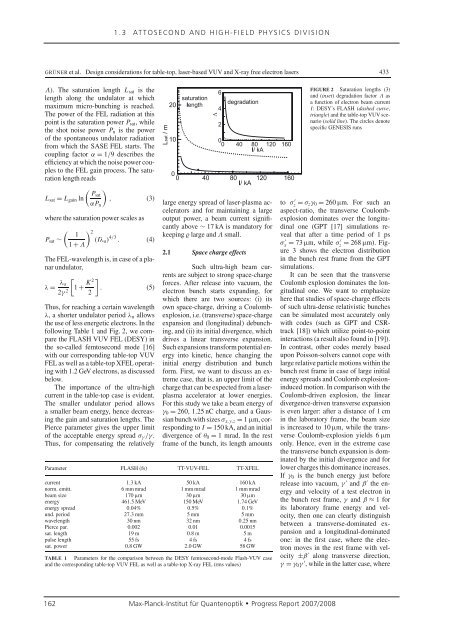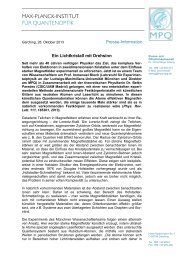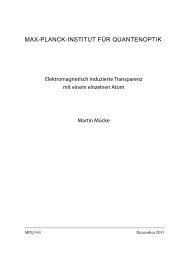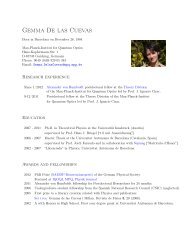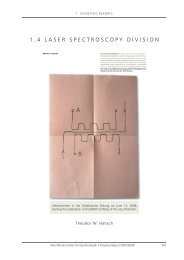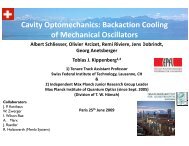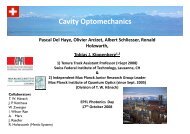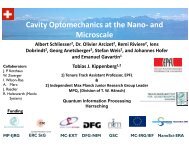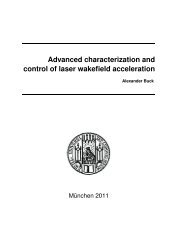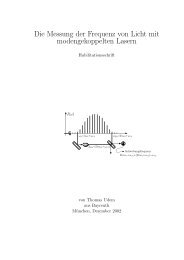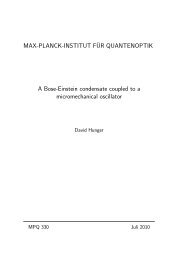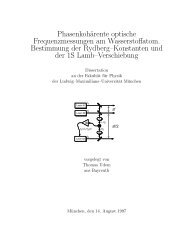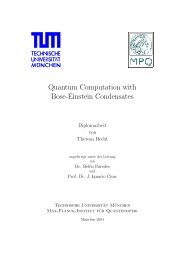Attosecond Control and Measurement: Lightwave Electronics
Attosecond Control and Measurement: Lightwave Electronics
Attosecond Control and Measurement: Lightwave Electronics
Create successful ePaper yourself
Turn your PDF publications into a flip-book with our unique Google optimized e-Paper software.
1 . 3 AT T O S E C O N D A N D H I G H - F I E L D P H Y S I C S D I V I S I O N<br />
GRÜNER et al. Design considerations for table-top, laser-based VUV <strong>and</strong> X-ray free electron lasers 433<br />
Λ). The saturation length Lsat is the<br />
length along the undulator at which<br />
maximum micro-bunching is reached.<br />
The power of the FEL radiation at this<br />
point is the saturation power Psat, while<br />
the shot noise power Pn is the power<br />
of the spontaneous undulator radiation<br />
from which the SASE FEL starts. The<br />
coupling factor α = 1/9 describes the<br />
efficiency at which the noise power couples<br />
to the FEL gain process. The saturation<br />
length reads<br />
� �<br />
Psat<br />
Lsat = Lgain ln , (3)<br />
αPn<br />
where the saturation power scales as<br />
� �2 1<br />
Psat ∼ (Iλu)<br />
1 + Λ<br />
4/3 . (4)<br />
The FEL-wavelength is, in case of a planar<br />
undulator,<br />
λ = λu<br />
2γ 2<br />
�<br />
1 +<br />
2 �<br />
K<br />
. (5)<br />
2<br />
Thus, for reaching a certain wavelength<br />
λ, a shorter undulator period λu allows<br />
the use of less energetic electrons. In the<br />
following Table 1 <strong>and</strong> Fig. 2, we compare<br />
the FLASH VUV FEL (DESY) in<br />
the so-called femtosecond mode [16]<br />
with our corresponding table-top VUV<br />
FEL as well as a table-top XFEL operating<br />
with 1.2 GeV electrons, as discussed<br />
below.<br />
The importance of the ultra-high<br />
current in the table-top case is evident.<br />
The smaller undulator period allows<br />
a smaller beam energy, hence decreasing<br />
the gain <strong>and</strong> saturation lengths. The<br />
Pierce parameter gives the upper limit<br />
of the acceptable energy spread σγ /γ .<br />
Thus, for compensating the relatively<br />
large energy spread of laser-plasma accelerators<br />
<strong>and</strong> for maintaining a large<br />
output power, a beam current significantly<br />
above ∼ 17 kA is m<strong>and</strong>atory for<br />
keeping � large <strong>and</strong> Λ small.<br />
2.1 Space charge effects<br />
Such ultra-high beam currents<br />
are subject to strong space-charge<br />
forces. After release into vacuum, the<br />
electron bunch starts exp<strong>and</strong>ing, for<br />
which there are two sources: (i) its<br />
own space-charge, driving a Coulombexplosion,<br />
i.e. (transverse) space-charge<br />
expansion <strong>and</strong> (longitudinal) debunching,<br />
<strong>and</strong> (ii) its initial divergence, which<br />
drives a linear transverse expansion.<br />
Such expansions transform potential energy<br />
into kinetic, hence changing the<br />
initial energy distribution <strong>and</strong> bunch<br />
form. First, we want to discuss an extreme<br />
case, that is, an upper limit of the<br />
charge that can be expected from a laserplasma<br />
accelerator at lower energies.<br />
For this study we take a beam energy of<br />
γ0 = 260, 1.25 nC charge, <strong>and</strong> a Gaussian<br />
bunch with sizes σx,y,z = 1 µm, corresponding<br />
to I = 150 kA, <strong>and</strong> an initial<br />
divergence of θ0 = 1 mrad. In the rest<br />
frame of the bunch, its length amounts<br />
Parameter FLASH (fs) TT-VUV-FEL TT-XFEL<br />
current 1.3 kA 50 kA 160 kA<br />
norm. emitt. 6 mm mrad 1 mm mrad 1 mm mrad<br />
beam size 170 µm 30 µm 30 µm<br />
energy 461.5 MeV 150 MeV 1.74 GeV<br />
energy spread 0.04% 0.5% 0.1%<br />
und. period 27.3 mm 5 mm 5 mm<br />
wavelength 30 nm 32 nm 0.25 nm<br />
Pierce par. 0.002 0.01 0.0015<br />
sat. length 19 m 0.8 m 5 m<br />
pulse length 55 fs 4 fs 4 fs<br />
sat. power 0.8 GW 2.0 GW 58 GW<br />
TABLE 1 Parameters for the comparison between the DESY femtosecond-mode Flash-VUV case<br />
<strong>and</strong> the corresponding table-top VUV FEL as well as a table-top X-ray FEL (rms values)<br />
162 Max-Planck-Institut für Quantenoptik • Progress Report 2007/2008<br />
FIGURE 2 Saturation lengths (3)<br />
<strong>and</strong> (inset) degradation factor Λ as<br />
a function of electron beam current<br />
I: DESY’s FLASH (dashed curve,<br />
triangle) <strong>and</strong> the table-top VUV scenario<br />
(solid line). The circles denote<br />
specific GENESIS runs<br />
to σ � z = σzγ0 = 260 µm. For such an<br />
aspect-ratio, the transverse Coulombexplosion<br />
dominates over the longitudinal<br />
one (GPT [17] simulations reveal<br />
that after a time period of 1 ps<br />
σ � x = 73 µm, while σ � z = 268 µm). Figure<br />
3 shows the electron distribution<br />
in the bunch rest frame from the GPT<br />
simulations.<br />
It can be seen that the transverse<br />
Coulomb explosion dominates the longitudinal<br />
one. We want to emphasize<br />
here that studies of space-charge effects<br />
of such ultra-dense relativistic bunches<br />
can be simulated most accurately only<br />
with codes (such as GPT <strong>and</strong> CSRtrack<br />
[18]) which utilize point-to-point<br />
interactions (a result also found in [19]).<br />
In contrast, other codes merely based<br />
upon Poisson-solvers cannot cope with<br />
large relative particle motions within the<br />
bunch rest frame in case of large initial<br />
energy spreads <strong>and</strong> Coulomb explosioninduced<br />
motion. In comparison with the<br />
Coulomb-driven explosion, the linear<br />
divergence-driven transverse expansion<br />
is even larger: after a distance of 1 cm<br />
in the laboratory frame, the beam size<br />
is increased to 10 µm, while the transverse<br />
Coulomb-explosion yields 6 µm<br />
only. Hence, even in the extreme case<br />
the transverse bunch expansion is dominated<br />
by the initial divergence <strong>and</strong> for<br />
lower charges this dominance increases.<br />
If γ0 is the bunch energy just before<br />
release into vacuum, γ � <strong>and</strong> β� the energy<br />
<strong>and</strong> velocity of a test electron in<br />
the bunch rest frame, γ <strong>and</strong> β ≈ 1 for<br />
its laboratory frame energy <strong>and</strong> velocity,<br />
then one can clearly distinguish<br />
between a transverse-dominated expansion<br />
<strong>and</strong> a longitudinal-dominated<br />
one: in the first case, where the electron<br />
moves in the rest frame with velocity<br />
±β� along transverse direction,<br />
γ = γ0γ � , while in the latter case, where


